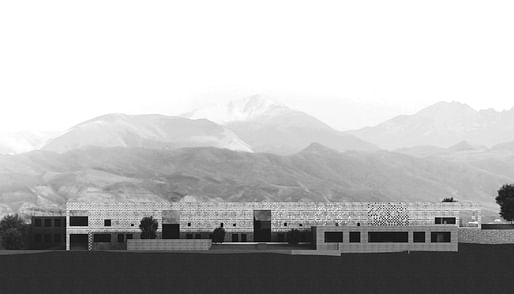

EMBEDDED EARTH
Concept:
Our proposal is a gentle earthen form, emerging from the slope of the upper plateau at the proposed site. Formed from the land it sits upon, this block is defined by its’ pakhsa wall. It is perforated with light and adorned with symbolic afghan tiles that will glimmer in the high altitude sun. Situated parallel to the great Buddha cliffs, the building orientation maximizes views of the valley and surrounding mountains. The building is intended to have a prominent presence in the Bamiyan valley, while maintaining a sense of belonging with the local architecture. Given the community-oriented program and complimentary vernacular construction, we see this design as the first step in a larger effort to raise cultural awareness, creating a sense of stewardship and the celebration of heritage and opportunity.
Form:
The building appears as a long rectangular volume that serves the public on two levels. A gallery (the cultural sanctuary) is located on the first level, while classrooms and performance areas (the cultural incubator) are located on the lower level. The interior of the volume is expressed as a modular concrete frame wrapped with a protective pakhsa envelope. A series of wings are located adjacent to the main volume. These will contain auxiliary and private functions as well as an exterior sculpture garden.
Experience:
Approaching the Bamiyan Cultural Centre from a gently sloping ramp, the exterior form of the building frames views of the Buddha cliffs beyond. Inside the main block, perforations in the pakhsa envelope blur the experience of interior and exterior. Several open courtyards subdivide the length of the building, and serve to heighten the dynamic relationship between the viewer and scenery.
On the entry level, gallery spaces aim to protect the artifacts of a diverse culture. Below, a public corridor connects researchers, performers and students, fostering a lively exploration of cultural tradition for generations to come.
The circulation path through the gallery is deliberately open and flexible, with the ability to respond to changing needs of display. The gallery spaces are shielded from harsh direct sun, with natural light diffused into the space from the clerestory above. Occasional windows and courtyards offer composed views to the cliffs and mountains as one progresses through the gallery. A wing housing research and collection storage, study rooms, and library follows the series of gallery spaces. At the end of the gallery progression, the building opens to views of the valley and cliffs beyond.
After encountering these spectacular views of the valley, a grand stair descends to the lower level, where social and educational spaces are connected by a series of exterior courtyards and an interior corridor that leads back to the reception. This corridor serves as an internal road along which are views to the valley, access to exterior spaces, classrooms, and various performance areas. Facing the valley is a group of large landscaped steps that serve as an outdoor amphitheater and a place to view the cliffs and rest. The exterior sculpture garden is located on the south side of the building, directly across from the amphitheater. A large outdoor terrace and garden anchors the east end of the building and provides views over the valley and beyond. At the end of this internal road, the visitor will find the gift shop and the tea house, which connects to a large exterior patio.
Construction:
The construction of the Bamiyan Cultural Centre will engage local laborers and craftsmen. The material palette was chosen for its local sourcing, resource efficiency and traditional use.
Pakhsa (rammed earth) construction is one of the simplest and most accessible technologies in the assembly. It celebrates the tradition and heritage of pakhsa construction, and the skill of the people who build it. The pakhsa envelope is formed from the earth found on site and has great insulating values. A grid of circular indentations will be cast into the envelope to add a playful and tangible element to an already engaging method of construction. These circular indentations can be left alone, cut further to become openings and windows, or adorned with paillettes. We envision the opportunity to generate funds by enabling sponsorship of these symbolic tiles. With the ability to add more over time, we see this as a progressive and engaging means of promotion and expansion for the Bamiyan Cultural Centre. As representations of traditional craft, the paillettes become symbols of cultural diversity and generate awareness within the greater community.
The pakhsa envelope rests on a concrete (or local masonry) plinth. The auxiliary wings will also be constructed of concrete so as to not compete visually with the pakhsa envelope. There is an interior concrete modular frame and slab system for the floors and roof structure. Concrete was selected for its structural performance, local availability, and thermal mass properties. Locally sourced glazed tiles grace the interior floor. Glass is used efficiently to allow for light and views, with appropriate shading to diffuse direct sun.
Environmental Resource and Efficiency:
During the winter, the interior is heated by a geothermal ground source heat pump system with radiant heated floors. The concrete floors act as thermal mass, and the pakhsa envelope will insulate in winter and regulate heat in the summer. The building will be well-insulated to sustain the interior temperatures and reduce stress on the geothermal system. Photovoltaic panels on the roofs and above the parking area will provide power for building operations. The system will also need to incorporate back-up generators or batteries. Unless covered by photovoltaic panels, the roof surfaces are either paved patio or planted. This will reduce the heat load of the building, help with water run-off and allow for more accessible exterior spaces. Trench systems will catch run-off and help irrigate the landscape systems on the plateau and slope. An underground well will provide water for the facility.
Status: Competition Entry